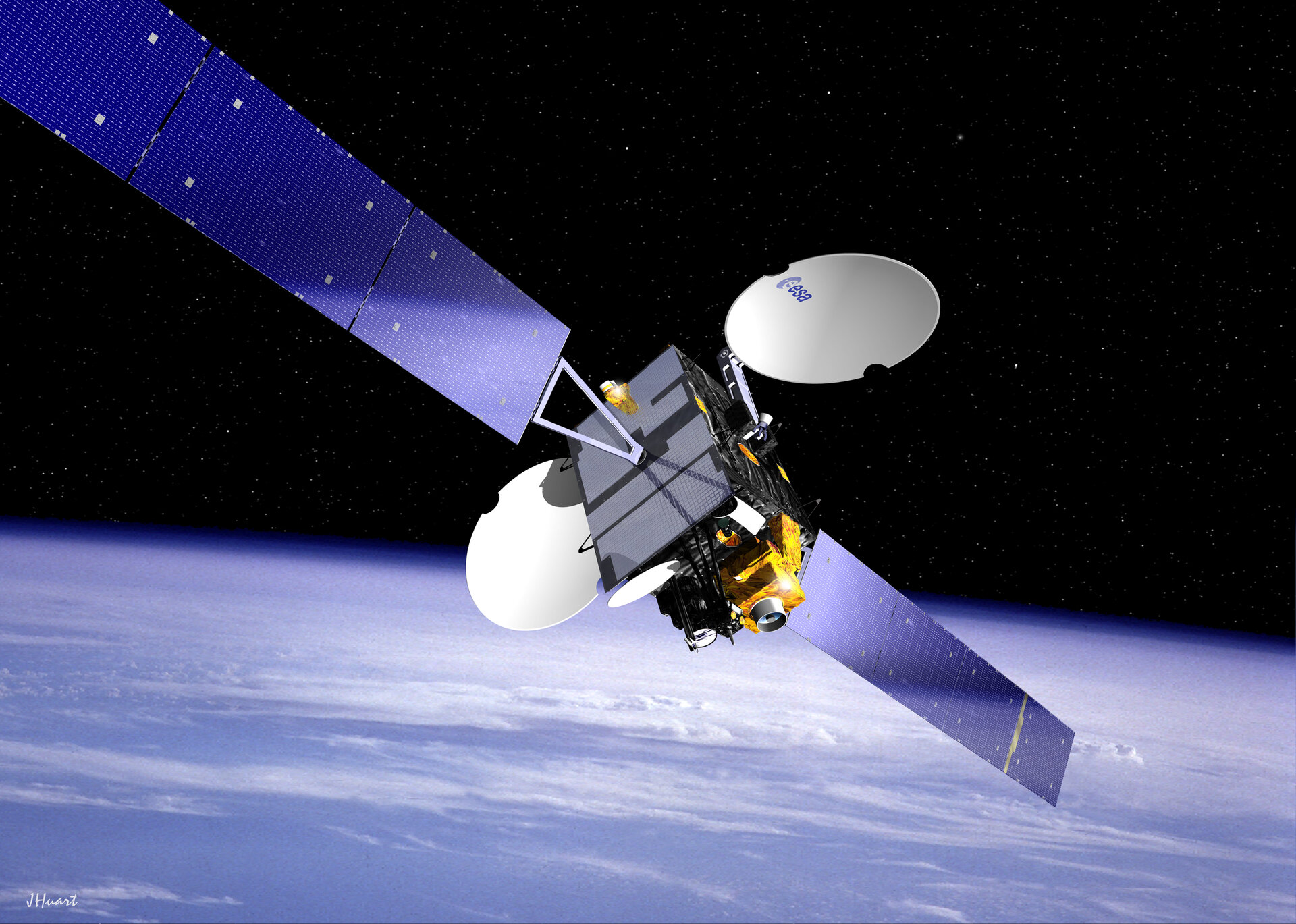Artemis finally reaches operational orbit
ESA PR 07-2003. Artemis has finally reached geostationary orbit, some 36 000 km above the Earth, at 21.5°E.
This announcement would, if all had gone to plan, been made just a few days after lift-off on 12 July 2001. Now, eighteen months and some serious brainstorming further on, the most advanced ESA telecommunications satellite ever commissioned is on station, ready to play its part in the development of new telecommunications services.
It will be remembered that Artemis (which stands for Advanced Relay and Technology Mission) was left in a lower than intended orbit when the Ariane 5 upper stage malfunctioned. It was even feared at the time that the entire mission might be lost. But thanks to creative thinking, often under severe time pressure, by engineering and other specialists from the European Space Agency, from prime contractor Alenia Spazio, from Astrium, which designed the ionic propulsion system, and from Telespazio, responsible for satellite operations at the Fucino control centre, satellite and mission have now been recovered.
Novel, unplanned use of the ion propulsion technology built into Artemis was the key to this success.

Initially provided on an experimental basis to correct orbit drift once Artemis was on station, the ion propulsion system* was used to raise the satellite’s orbit from 31 000 km to 36 000 km.
This is a much slower process than using a conventional apogee boost motor – a bit like using an outboard motor to drive an ocean liner – but here it was a case of better late than never!
Before the orbit-raising operations could get underway, a huge reprogramming effort was required and it even proved necessary to develop completely new software from scratch, against the clock. Those operations began with an initial, rapid shift to a safe parking orbit beyond the upper Van Allen Radiation Belt, the required thrust coming from the satellite’s conventional, chemical-powered apogee boost motors. The small ionic motors then took over in February 2002 and, at an average of 15 kilometres a day, Artemis rose in spirals towards geostationary orbit. Needless to say, there were incidents and unexpected problems on the way, as engineers strove to make a system do a job for which it had not been designed.
Slowly but surely then, Artemis progressed towards its final destination, demonstrating its intrinsic modernity and illustrating the merits of a satellite of this kind, designed to test new technologies and services.

It should be noted that in the final approach phase the chemical motor fired thrice in succession to adjust the satellite’s velocity.
Artemis has now taken up its operational station in Earth orbit and its instruments, placed in hibernation throughout the recovery campaign, have been reactivated. But while its real job is only just beginning, Artemis already has a world first to its credit, earned when its communications payloads were checked out from the ground while preparations for the orbit-raising operations proceeded. The highlight of those checks came when a link was established between the CNES SPOT-4 Earth observation satellite and Artemis (see ESA press release no. 75/2001); imaging data from SPOT-4 was transmitted by laser to Artemis and from there by radio waves to the Spot Image processing centre in Toulouse. An unprecedented link-up between satellites in space!
Once all systems are fully active Artemis will be ready to embark on what may prove to be a ten-year operational career, barely less than the service life that had been planned before these celestial gymnastics became necessary – and which have in the end provided a wealth of information and experience for future missions.
(*) The principle of any kind of thrusters in space is to accelerate molecules and expel them from the satellite at the highest possible speed. Conventional thrusters use a chemical reaction between fuel and oxidiser to heat a gas and eject the molecules at a speed of typically 1 km/sec. Electrical propellant systems first ionise (i.e. electrically charge) the molecules of a gas (xenon, for instance). The ionised gas is then accelerated by electrical fields and ejected from the satellite at a speed of typically 30 km/sec.
For further information, please contact:
ESA Media Relations Service
Tel: +33(0)1.53.69.7155
Fax: +33(0)1.53.69.7690















 Germany
Germany
 Austria
Austria
 Belgium
Belgium
 Denmark
Denmark
 Spain
Spain
 Estonia
Estonia
 Finland
Finland
 France
France
 Greece
Greece
 Hungary
Hungary
 Ireland
Ireland
 Italy
Italy
 Luxembourg
Luxembourg
 Norway
Norway
 The Netherlands
The Netherlands
 Poland
Poland
 Portugal
Portugal
 Czechia
Czechia
 Romania
Romania
 United Kingdom
United Kingdom
 Slovenia
Slovenia
 Sweden
Sweden
 Switzerland
Switzerland

































